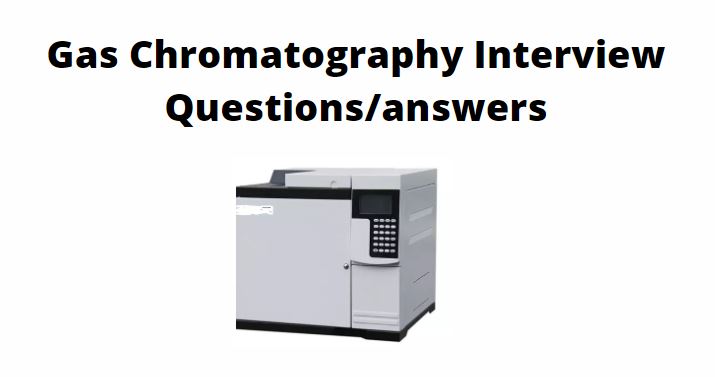Gas Chromatography Interview Questions and Answers are prepared based on the previously asked questions in top companies. Questions related to gas chromatography are helpful to the Quality Control Department.

Gas Chromatography Interview Questions and Answers in Pharmaceuticals
Q. What are the differences between QA and QC?
Ans: QC is a subcategory of QA that deals with checking if materials and medicinal products fulfill acceptance requirements. The QA function is often composed of verifying all activities., whereas the QC function is mainly composed of execution operations.
Q. What is Gas Chromatography?
Ans: Gas chromatography is a common type used in analytical chemistry for separating and analyzing compounds that can be vaporized without decomposition. Typically, GC includes testing the purity of a particular substance or separating the different components of the mixtures.
Q. What is the principle of Gas chromatography?
Ans: The principle of separation in gas chromatography is “partition”. the mixture of the components to be separated is converted to vapor and mixed with the gaseous mobile phase.
the components that are more soluble in the stationary phase travel slower and are eluted later. the components that are less soluble in the stationary phase travel faster and eluted out first.
Q. Which types of gases are used as a mobile phase in gas chromatography (GC)?
Ans: Inert gases are used as a mobile phase in gas chromatography. eg. Helium, Nitrogen, and Hydrogen.
Q. Why is GC called Gas chromatography?
Ans: The mobile phase that is used in GC is a carrier Gas.
Q. What is gas chromatography instrumentation?
Ans: GC has the following instrumentation:
- Gas Chamber
- Injection Port
- Detector
- Column compartment
- Recorder
Q. What is the stationary phase in Gas chromatography?
Ans: The stationary phase may be a solid adsorbent called gas-solid chromatography (GSC) or can be a liquid inert support called gas-liquid chromatography
Q. What do you mean by inert Gas?
Ans: Inert gas is a non-reactive gas. In general, they do not react with anything or any components, for this reason, they are known as an inert gas.
Q. Which types of components are used to separate in GC?
Ans: Only volatile components are used to separate in gas chromatography. for eg. IPA, ethanol, acetate, etc.
Q. What are the types of gas chromatography?
Ans:
- Gas chromatography is of two types:
- Gas solid chromatography (GSC)
- Gas-liquid chromatography (GLC)
Q. How to identify the peak in GC?
Ans: This question may be hard but you can explain it in sample ways as; GC works on different factors such as temperature, gas flow, and column length. because of the factor affecting retention time, it is important that, if the gas chromatography has a specified method then it will be easy to identify the peaks in GC and understand the elution pattern of the peak.
In another way, peaks can be identified in GC by using the method name GCMS. In GCMS, the mass spectrometer is used and on the basis of the mass, the peak can be identified.
Q. How does Gas chromatography work?
Ans: When the sample solution is injected through the injection port, the sample is entered into a column. due to the high temperature in the column, the sample gas evaporates and travels through the column with the MP.
The temperature is set in such a way that the component should get a response at its boiling points only. As opposed to high boiling point components, those with a lower boiling point will elute first.
Q. What is the difference between ALS and Headspace?
Ans: ALS is used to inject liquid samples and evaporates them into the column and headspace is used to convert liquid/ solid samples into vapor form and inject them into the column.
Q. What are gas chromatography detectors?
Ans: The following are the GC Detectors:
- Flame ionization detector (FID)
- Thermal conductivity detector (TCD)
- Nitrogen phosphorous detector (NPD)
- Electron capture detector (ECD)
- Flame photometric detector (FPD)
- Photoionization detector (PID)
- Electrolytic conductivity detector (ELCD)
- Mass spectrometer (MS)
Q. What is the difference between FID and TCD?
Ans: FID is a flame ionization of organic compounds by burning the compound in a hydrogen-air flame.
TCD is based on the difference in thermal conductivity properties between carrier gas and the target being detected.
Q. How many types of columns are used in gas chromatography?
Ans: Mainly two types of columns used in gas chromatography:
- Packed column (glass or stainless steel)
- Capillary column: (Fused quartz)
Related Post: HPLC Interview Questions and Answers (Mostly Asked)
Q. What are the 3 types of autosamplers?
Ans:
- Headspace autosampler
- Liquid autosampler
- Solid phase microextraction (SPME)
Q. which type of component is detected by the FID detector?
Ans. To detect organic types of compounds (other than formaldehyde and formic acid).
Q. What is the size of the packed & capillary column in GC?
Ans: Packed column length: 1 to 3 meters, internal diameters: 2 to 4 mm.
Capillary column: length (10 to 100 meters) and internal diameters: 0.1 to 1mm.
Q. Which materials are used in the GC column as a stationary phase?
Ans: For the stationary phase in GC, silicone grease or wax is employed.
Q. What are the components of gas chromatography?
Ans: Carrier gas>flow controller> injector port> column> column oven> detector> recorder.
Q. What is the makeup Gas in GC?
Ans: Makeup gas is a gas flow that is used to sweep components through a detector to minimize band broadening. depending on the GC_Brand and detector design, the use of makeup gas can improve sensitivity.
Q. What is zero air in gas chromatography?
Ans: Zero air is the air that removes hydrocarbon via a process of oxidative catalysis to ensure it only contains less than 0.1 PPM of total hydrocarbons. For these applications, pressurized gas cylinders or a gas generator are typically used to supply zero air.
Q. Which detector is commonly used in Gas chromatography?
Ans: The flame ionization detector (FID) is most commonly used in gas chromatography for its reliability and sensitivity in detecting organic vapors or organic types of compounds.
Q. On what basis molecules are separated in GC?
Ans: In GC molecules are separated on the basis of boiling points. less billing point molecules elute first as compared to more boiling point molecules.
Q. If boiling points are the same then which molecules elute first?
Ans: In the case of the same boiling points, molecules are separated on the basis of the size of their molecules. small size molecules elute first as compared to large size.
Q. What is the split ratio in GC?
Ans: The split ratio is calculated by dividing the column carrier gas flow rate by the split vent flow rate. for example, For instance, a split ratio of 1:5 indicates that 5 times as much carrier gas is exiting the split vent as is entering the column.
Q. What are the parameters of the GC calibration?
Ans: Calibration parameters of Gas chromatography (GC) are carrier gas flow accuracy, calibration of flame ionization detector (FID) by linearity measurement, calibration of auto-injector by linearity measurements, calibration for column oven temperature measurements, etc.
Gas Chromatography Interview Questions Related to Applications, Advantages, and Limitations.
Q. What is the advantage of Gas chromatography?
Ans:
- Gas chromatography has high-resolution power compared to other methods
- High sensitivity
- High precision and accuracy
- It quickly analyses the sample (in minutes or even in seconds)
- Need a small sample (ul-ug)
Q. What are the disadvantages of Gas chromatography?
Ans:
- For GC analytes must be thermally stable
- Analyte must be relatively volatile
- GC is not possible to operate under biological conditions
- If the above conditions are not critical, then GC is probably the best means for analyzing the complex sample.
Q. What types of molecules elute first in GC?
Ans: Low boiling points are eluting first in GC.
Q. What are the applications of GC?
Ans: The following are the applications of GC:
- Chemical industries
- R&D
- QC in the pharmaceutical industries
- Forensic science labs
- Food industries
- Petroleum and Petrochemical
- Air pollution measurement
- Wine industries
- Alcohol analysis in blood
Note: Visit daily here to get updated Questions related to Gas Chromatography.
Gas Chromatography Interview Questions and Answers pdf will be provided shortly.
